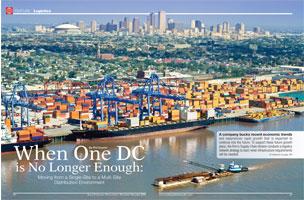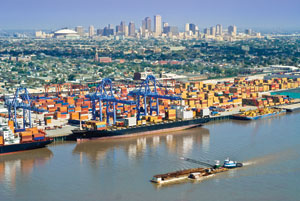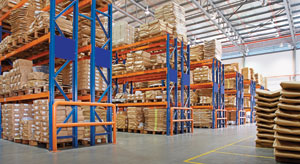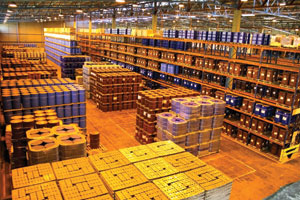
 A company bucks recent economic trends and experiences rapid growth that is expected to continue into the future. To support these future growth plans, the firm’s Supply Chain division conducts a logistics network strategy to learn what infrastructure requirements will be needed. The strategic recommendations show all of the stakeholders throughout the organization that the capacity of the single East Coast distribution center will not be sufficient to support future growth, and a second distribution center will provide additional opportunity to reduce operating costs and improve transit times to customers while supporting growth. The Supply Chain division begins development of a conceptual design, and Real Estate begins the site selection process in the area that was recommended during the network strategy.
A company bucks recent economic trends and experiences rapid growth that is expected to continue into the future. To support these future growth plans, the firm’s Supply Chain division conducts a logistics network strategy to learn what infrastructure requirements will be needed. The strategic recommendations show all of the stakeholders throughout the organization that the capacity of the single East Coast distribution center will not be sufficient to support future growth, and a second distribution center will provide additional opportunity to reduce operating costs and improve transit times to customers while supporting growth. The Supply Chain division begins development of a conceptual design, and Real Estate begins the site selection process in the area that was recommended during the network strategy.
While Supply Chain and Real Estate will be impacted heavily during the early stages of the design and implementation of the second DC, leaving those groups to drive the implementation process alone would be short-sighted and will ensure a difficult, if not impossible, facility startup for this example company. Many other stakeholders within the firm should be working closely with these groups to ensure a seamless transition into a multi-DC environment. I would suggest that adding the second location in a distribution network requires an organizational transformation. There are many new requirements that have to be identified and developed in a multi-facility distribution network that were not necessary for a single-facility network. Existing processes upstream and downstream of the distribution operation must be reviewed and revised, and the implementation of the facility itself must be integrated between many different work streams.
What stakeholders should be involved in the facility implementation?
At Fortna, we always approach any implementation of a new facility as a program. The following must be integrated into one program throughout the design and implementation process in order for facility go-live to proceed smoothly:
People
Operational Processes
Systems
Facility
Equipment
Company and partner stakeholders in these areas must be engaged throughout in order for timelines to be met and implementation issues to be resolved quickly. Other stakeholders that are typically included are construction management, customer service, procurement/sourcing, and transition management. The goal is to efficiently integrate the new DC into the existing distribution network on schedule and on budget while improving service and reducing the overall total cost to serve in the future.
 Sourcing and Receiving Requirements
Sourcing and Receiving Requirements
As facility and operational requirements are being developed, decisions of how product and information will flow from supply or manufacturing locations to the distribution network must be made. Many functions are impacted when product flow is split between two distribution facilities. Questions that typically have to be answered include:
Do supply points need to be changed to service the new DC? – This needs to be considered in all cases, but especially if there is a large amount of domestic supply volume. There could be candidate vendors that could provide the same goods with the same or better quality near the new facility to reduce transportation cost and transit time to the DC. Vendor compliance can be a factor as well, with different rules of engagement possible in a multi-facility distribution network versus a single-facility network.
What will the inventory strategy and deployment rules be? – The vision that was developed during a network strategy has provided directional guidance around inventory strategy and deployment, but the details must be addressed during facility design. Focus around these requirements is necessary to ensure storage and throughput capacity requirements are met, as well as supporting upstream and downstream decision-making requirements:
Types of SKUs that will be handled at each location (break pack, full case, ship-alone large items, haz-mat, temperature-controlled).
Slow-moving SKUs in single or multiple locations.
Core product deployment versus seasonal product deployment.
Channel service requirements (Direct, Retail, Wholesale, Multi-channel).
How will product flow from supply points to multiple distribution centers? – Guidance at a high-level should be provided during the strategic analysis to answer this question as well, but detailed analysis by product type and vendor needs to be conducted. Issues to consider include:
Break bulk centers at ports to deconsolidate or consolidate shipments from overseas and domestic vendors.
Cross-dock capabilities at the new and existing facilities to allow for deconsolidation/transfer operations to be efficient.
Bypassing internal distribution altogether and ship some products direct to stores or customer locations.
Based upon inventory strategy and facility locations, how should the merchandising, procurement and planning functions operate? – Requirements for multiple-destination purchase orders, “optimal” SKU ordering characteristics (style/color assortments, prepacks, case quantities), order frequency and quantity requirements, and adjustment of order lead times to account for multiple origins and destinations are a few of the important considerations that must be addressed.
How will the inbound transportation requirements change? – The impact of splitting inbound shipments between multiple distribution facilities on vendor order minimums and freight costs and levels must be understood. A rule set by each vendor must be developed as part of the systematic management of these requirements. If a core carrier program is in place, determination must be made if it provides the same benefit to the future distribution network as it does to the existing network. Also, new carriers for the lanes transporting product into the new facility may have to be engaged.
How will inventory allocation between facilities be managed at a tactical level? – Allocation timing becomes a key consideration in a multi-site distribution operation. In most instances, best practice is to delay inventory allocation activities of inbound receipts to orders as close to time of receipt as possible. However, the timing of product ownership and inventory visibility and systems play a large role.
What are the systems requirements necessary to support multi-site transportation, merchandising, purchasing and allocation requirements?– One of the biggest issues that must be overcome when transitioning from single- to multi-facility distribution is defining the system requirements to manage the product and information flow from buyers and vendors into a multi-site operation. Inventory management systems, planning and allocation systems, and purchasing systems will have to be modified, or in some instances, replaced. A Distributed Order Management system that allows effective management of multi-site distribution and allocation requirements is a key system that is typically not found in a single-DC distribution network. A transportation management system that provides visibility to the flow of inbound product from vendors to multiple facilities will be required, as well.
It is important to realize that these questions cannot be answered independently; every decision made in one of these areas has a ripple effect up and down the supply chain. Focus around the integration of all of these areas during the operations design process has to be a top priority.
Demand Fulfillment Requirements
 Just as the functions involved in the procurement and management of the inbound inventory that is being moved into the new distribution center require modification, the requirements for effectively managing distribution and transportation operations that move product through the multi-facility distribution network to customers also have to be considered. The impact to customer order allocation to facilities in a multi-site distribution network is tremendous, with rule sets that have to be generated based upon SKU characteristics or product group, transportation mode, customer location and service requirements, and inventory availability. Inventory and order profiles may dictate different types of operational and waving processes for the new facility, and systems requirements and training programs may have to be modified or replaced to account for these differences.
Just as the functions involved in the procurement and management of the inbound inventory that is being moved into the new distribution center require modification, the requirements for effectively managing distribution and transportation operations that move product through the multi-facility distribution network to customers also have to be considered. The impact to customer order allocation to facilities in a multi-site distribution network is tremendous, with rule sets that have to be generated based upon SKU characteristics or product group, transportation mode, customer location and service requirements, and inventory availability. Inventory and order profiles may dictate different types of operational and waving processes for the new facility, and systems requirements and training programs may have to be modified or replaced to account for these differences.
Demand fulfillment requirements can also have an impact on facility and material handling design. Order types will play a huge role in the level of automation in the facility and the way the building is constructed. Land and construction costs combined with future growth will dictate how future expansions will be phased for the new distribution center. Other issues that must be tackled as a part of the overall integration of the second facility into the distribution network include:
What SKUs will be rationalized for each facility in the distribution network? -- If the strategic direction for the distribution network is to regionalize demand requirements to provide improved customer service at a lower operating cost, the increased safety stock inventory investment and carrying cost in the distribution network to carry a full line of SKUs in multiple facilities is the penalty. Other times, it may be determined that only fast-moving SKUs or SKUs with certain characteristics or for certain demand channels will be carried in one facility, while the other carries the full line of SKUs. Whatever the rationalization for the SKUs that are carried in a new facility, the equipment, facility, operations, systems and people requirements will be impacted by the decision.
How will customer orders be fulfilled? – Requirements for different order types will dictate design requirements for the new facility. Carton picks, pallet picks, broken case picks and ship-alones all have design considerations that must be understood. One other item of significance in customer order fulfillment relates to how multi-line orders are completed if the entire order cannot be filled from one DC with the inventory that is in-stock. It must be determined if customers will accept split shipments from multiple distribution locations, or if the customer must receive all line items in one shipment from a single location. Another element of this rule set is that customers may be given a choice depending upon the order profile or the season. In these situations, product transfer management between facilities, and in-transit inventory visibility becomes an important function in the new distribution network.
How will demand fluctuations and seasonality impact facility operations? – Storage strategy during peak season can play a role in how the investment requirements for the facility and storage equipment are impacted. Offsite storage for peak requirements can mitigate initial investment requirements, but add operational complexities. The disposition of special projects or value-added services like gift wrapping during peak seasons must be determined as well.
What are the systems requirements to effectively fulfill demand in a multi-site distribution network? – The Warehouse Management (WM) system that is in place in the existing distribution center may not meet the requirements of the new distribution center if there are different processes and fulfillment requirements needed. Even if the new facility is a mirror image of the existing one, host and order management interface requirements still will be required. A Distributed Order Management system plays a huge role in demand fulfillment as it has real-time integration with key business systems, and provides real-time order status and visibility. Companies that primarily support wholesale and retail distribution channels may need a Transportation Management System to support new multi-site transportation requirements.
Transitioning from one distribution center to more than one distribution center is not solely a distribution and transportation function effort. Company stakeholders ranging from vendor relations through customer service are impacted by this transformational change and need to be involved to define the most effective multi-site distribution network that minimizes the total cost to serve and maximizes customer service. Designing the building, material handling equipment, and systems needed to support the operating requirements of the new facility requires input and integration from all of the stakeholders discussed here; otherwise, the overall effectiveness of a multi-site distribution environment will be reduced, and the business case outlined in the strategy could be jeopardized.

